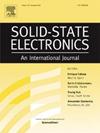用于改善片上单片变压器特性的富阱高电阻硅
IF 1.4
4区 物理与天体物理
Q3 ENGINEERING, ELECTRICAL & ELECTRONIC
引用次数: 0
摘要
本文利用实验测量和电磁模拟,研究了采用富阱层(HR-Si + TR)的高电阻率衬底实现的单片片上平面变压器的性能。在标准硅(Std-Si)和HR-Si + TR上制作、测量和模拟了两种变压器拓扑,即交错和同心拓扑,以评估衬底损耗的影响。提取并比较了自谐振频率(SRF)、互感系数、无功耦合系数和电阻耦合系数以及最大功率传输效率等关键性能指标。结果表明,HR-Si + TR衬底显著增强了这两种拓扑结构:对于交错变压器,SRF从3.66 GHz提高到3.80 GHz提高了3.8%,峰值功率传输效率从1.42 GHz的0.33提高到2.26 GHz的0.63,几乎翻了一番;对于同心变压器,SRF从3.12 GHz提高到4.10 GHz,提高了31%以上,效率从1.48 GHz时的0.06提高到2.15 GHz时的0.22,提高了三倍多。这些改进源于HR-Si + TR衬底能够通过最小化衬底中的涡流损耗和提高RC漏径对地的阻抗,从而大大降低电阻互耦系数,从而限制了走线串扰和走线之间的功率泄漏。这种优势在同心拓扑结构中尤为明显,较大的绕组间距放大了基材损耗降低的影响。本文章由计算机程序翻译,如有差异,请以英文原文为准。
Trap-rich high-resistivity silicon for improved on-chip monolithic transformers characteristics
This paper investigates the performance of monolithic on-chip planar transformers implemented on high-resistivity substrates incorporating a trap-rich layer (HR-Si + TR), using both experimental measurements and electromagnetic simulations. Two transformer topologies, i.e., interleaved and concentric, were fabricated, measured, and simulated on both standard silicon (Std-Si) and HR-Si + TR to assess the impact of substrate losses. Key figures of merit, including self-resonant frequency (SRF), mutual inductance, reactive and resistive coupling factors, and maximum power-transfer efficiency, were extracted and compared. Results show that the HR-Si + TR substrate markedly enhances both topologies: for the interleaved transformer, the SRF increases by 3.8 % from 3.66 to 3.80 GHz, while the peak power-transfer efficiency nearly doubles from 0.33 at 1.42 GHz to 0.63 at 2.26 GHz; for the concentric transformer, the SRF rises by over 31 % from 3.12 to 4.10 GHz, and the efficiency increases more than threefold from 0.06 at 1.48 GHz to 0.22 at 2.15 GHz. These improvements arise from the HR-Si + TR substrate’s ability to substantially reduce the resistive mutual coupling factor by minimizing eddy current losses in the substrate and raising the impedance of the RC leakage path to ground, thereby limiting trace crosstalk and power leakage between traces. The benefits are particularly pronounced in the concentric topology, where the larger winding separation amplifies the impact of reduced substrate-induced losses.
求助全文
通过发布文献求助,成功后即可免费获取论文全文。
去求助
来源期刊

Solid-state Electronics
物理-工程:电子与电气
CiteScore
3.00
自引率
5.90%
发文量
212
审稿时长
3 months
期刊介绍:
It is the aim of this journal to bring together in one publication outstanding papers reporting new and original work in the following areas: (1) applications of solid-state physics and technology to electronics and optoelectronics, including theory and device design; (2) optical, electrical, morphological characterization techniques and parameter extraction of devices; (3) fabrication of semiconductor devices, and also device-related materials growth, measurement and evaluation; (4) the physics and modeling of submicron and nanoscale microelectronic and optoelectronic devices, including processing, measurement, and performance evaluation; (5) applications of numerical methods to the modeling and simulation of solid-state devices and processes; and (6) nanoscale electronic and optoelectronic devices, photovoltaics, sensors, and MEMS based on semiconductor and alternative electronic materials; (7) synthesis and electrooptical properties of materials for novel devices.
 求助内容:
求助内容: 应助结果提醒方式:
应助结果提醒方式:


